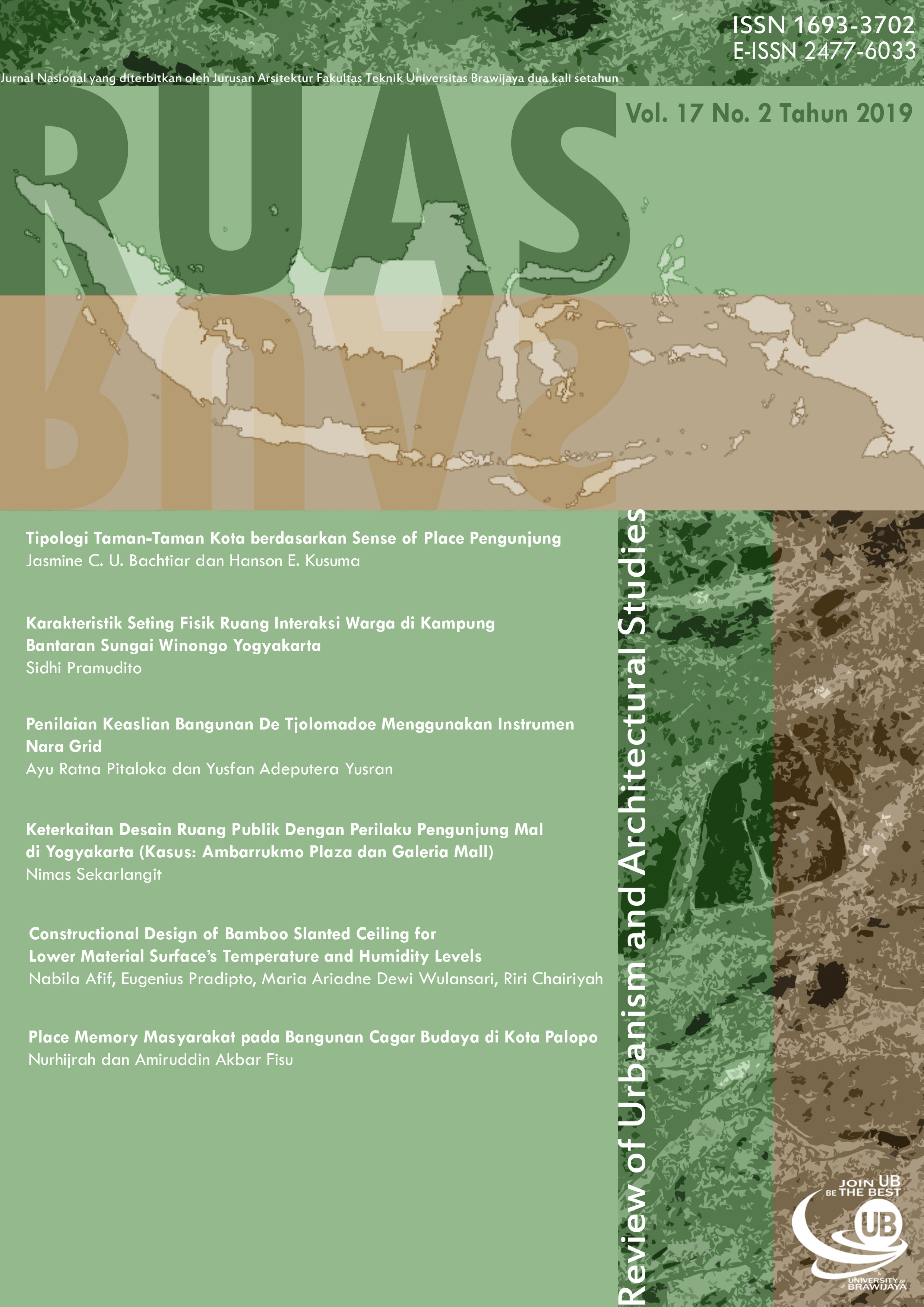Tipologi Taman-Taman Kota berdasarkan Sense of Place Pengunjung
DOI:
https://doi.org/10.21776/ub.ruas.2019.017.02.1Keywords:
Landscape architecture, time spent, sense of place, urban parksAbstract
The provision of urban green areas, especially urban parks, has been decreasing as higher demand for public facilities in the city. Urban parks, however, provide many benefits for surrounding residents that require effort to sustain them. The current study wants to identify how grouping (typology) of urban parks was based on visitor’s attitudes toward urban parks (sense of place). The data were collected online from the questionnaire, and the data of 211 respondents were collected. The data were then processed quantitatively by open coding, axial coding, and selective coding analyses. The result shows that there were two groups of urban parks based on visitor’s attitudes; they are restorative parks and forest parks. The restorative park can provide restoration benefits for daily visitors, while forest parks can provide not only restoration effects but also visitor’s hobby activities. Based on the duration of the visit to those parks, the level of visitor’s sense of place in the forest park is higher than in the restorative park. The role of the architect and urban planner is needed to design urban parks that can develop visitor’s sense of place, such as providing a place for attraction, physical activity, walking, photography, relaxation, and enjoy the atmosphere.
References
Armas, D. Q., & Soelaiman, T. M. A. (2017). Kegiatan Joging dan Tempat-Tempat Aktivitas Joging di. In Temu Ilmiah IPLBI 2017 (pp. 47–52).
Bahrini, F., Bell, S., & Mokhtarzadeh, S. (2017). The Relationship between The Distribution and Use Patterns of Parks and Their Spatial Accessibility at The City Level: A Case Study from Tehran, Iran. Urban Forestry & Urban Greening, 27, 332–342. https://doi.org/10.1016/j.ufug.2017.05.018
Buta, N., Holland, S. M., & Kaplanidou, K. (2014). Local Communities and Protected Areas : The Mediating Role of Place Attachment for Pro-environmental Civic Engagement. Journal of Outdoor Recreation and Tourism, 5–6, 1–10. https://doi.org/10.1016/j.jort.2014.01.001
Creswell, J. W. (2007). Qualitative Inquiry and Research Design: Choosing among Five Approaches (2nd ed.). London: SAGE Publications.
Deng, J., Andrada, R., & Pierskalla, C. (2017). Visitors ’ and Residents ’ Perceptions of Urban Forests for Leisure in Washington D . C. Urban Forestry & Urban Greening, 28, 1–11.
Fauziah, A., Santosa, I., & Wahjudi, D. (2016). Thematic Concept on The Physical Element of Open Space Towards People’s Place Attachment in The City of Bandung. Global Journal of Arts, Humanities and Social Sciences, 4(7), 48–65.
Gatersleben, B., & Andrews, M. (2013). When Walking in Nature Is Not Restorative — The Role of Prospect and Refuge. Health & Place, 20, 91–101. https://doi.org/10.1016/j.healthplace.2013.01.001
Gidlof-Gunnarsson, A., & Ohrstrom, E. (2007). Noise and well-being in urban residential environments : The potential role of perceived availability to nearby green areas. Landscape and Urban Planning, 83(2–3), 115–126. https://doi.org/10.1016/j.landurbplan.2007.03.003
Gunawan, A., & Permana, S. (2018). Konsep Desain Ekologis Ruang Terbuka Hijau di Sudirman Central Business District (SCBD) sebagai Habitat Burung. Tata Loka, 20(2), 181–194.
Halpenny, E. A. (2010). Pro-Environmental Behaviours and Park Visitors : The Effect of Place Attachment. Journal of Environmental Psychology, 30(4), 409–421. https://doi.org/10.1016/j.jenvp.2010.04.006
Harris, V., Kendal, D., Hahs, A. K., & Threlfall, C. G. (2017). Green space context and vegetation complexity shape people ’ s preferences for urban public parks and residential gardens. Landscape Research, 6397(April). https://doi.org/10.1080/01426397.2017.1302571
Ingkadijaya, R., Damanik, J., Putra, H. S. A., & Nopirin. (2016). Aktivitas Wisata Pilihan Keluarga Perkotaan. Jurnal Khasanah Ilmu, 7(1), 39–44.
Jim, C. Y., & Chen, W. Y. (2006). Perception and Attitude of Residents Toward Urban Green Spaces in Guangzhou (China). PROFILE, 38(3), 338–349. https://doi.org/10.1007/s00267-005-0166-6
Korpela, K. M., Ylen, M., Tyrvainen, L., & Silvennoinen, H. (2010). Favorite Green, Waterside and Urban Environments, Restorative Experiences and Perceived Health in Finland. Health Promotion International, 25(2), 200–209. https://doi.org/10.1093/heapro/daq007
Linda, S., Van den Berg, A. E., & De Groot, J. I. M. (2013). Environmental Psychology: An Introduction. West Sussex: The British Psychological Society and John Wiley & Sons Ltd.
Milligan, C., & Bingley, A. (2007). Restorative Places or Scary Spaces ? The Impact of Woodland on the Mental Well-being of Young Adults. Health & Place, 13, 799–811. https://doi.org/10.1016/j.healthplace.2007.01.005
Najafi, M., & Shariff, M. K. B. M. (2011). The Concept of Place and Sense of Place In Architectural Studies. International Journal of Human and Social Sciences, 6(3), 187–193.
Pietilä, M., Neuvonen, M., Borodulin, K., Korpela, K., & Sievänen, T. (2015). Relationships between exposure to urban green spaces , physical activity and self-rated health. Journal of Outdoor Recreation and Tourism, 10, 44–54. https://doi.org/10.1016/j.jort.2015.06.006
Porajouw, E. F., Poluan, R. J., & Mastutie, F. (2017). Efektivitas Ruang Terbuka Publik di Kota Tomohon. Spasial, 4(1), 136–148.
Prakoso, S., & Dewi, J. (2017). Rasa Kelekatan Anak pada Ruang Publik Terpadu Ramah Anak (RPTRA). NALARs, 17(1), 1–10.
Relph, E. (1976). Place and Placelessness. London: Pion Limited.
Roe, J., Aspinall, P. A., & Thompson, C. W. (2016). Understanding Relationships between Health , Ethnicity , Place and the Role of Urban Green Space in Deprived Urban Communities. International Journal of Environmental Research and Public Health, 13(681), 1–21. https://doi.org/10.3390/ijerph13070681
Sang, O., Knez, I., & Gunnarsson, B. (2016). The Effects of Naturalness , Gender , and Age on How Urban Green Space is Perceived and Used. Urban Forestry & Urban Greening, 18, 268–276. https://doi.org/10.1016/j.ufug.2016.06.008
Schipperijn, J., Ekholm, O., Stigsdotter, U. K., Toftager, M., Bentsen, P., Kamper-jørgensen, F., & Randrup, T. B. (2010). Factors influencing the use of green space : Results from a Danish national representative survey, 95, 130–137. https://doi.org/10.1016/j.landurbplan.2009.12.010
Shamai, S. (1991). Sense of Place : an Empirical Measurement. Geoforum, 22(3), 347–358.
Smaldone, D. (2006). The Role of Time in Place Attachment. In Proceedings of the 2006 Northeeastern Recreation Research Symposium (pp. 47–56).
Thwaites, K., Helleur, E., & Simkins, I. M. (2005). Restorative Urban Open Space : Exploring the Spatial Configuration of Human Emotional Fulfilment in Urban Open Space Restorative Urban Open Space : Exploring the Spatial Configuration of Human Emotional Fulfilment in Urban Open Space. Landscape Research, 30(4), 525–547. https://doi.org/10.1080/01426390500273346
Whiting, J. W., Larson, L. R., Green, G. T., & Kralowec, C. (2017). Outdoor Recreation Motivation and Site Preferences across Diverse Racial/Ethnic Groups : A Case Study of Georgia State Parks. Journal of Outdoor Recreation and Tourism, 18, 10–21. https://doi.org/10.1016/j.jort.2017.02.001
Zhang, H., Chen, B., Sun, Z., & Bao, Z. (2013). Landscape Perception and Recreation Needs in Urban Green Space in Fuyang, Hangzhou, China. Urban Forestry & Urban Greening, 12(1), 44–52. https://doi.org/10.1016/j.ufug.2012.11.001
Downloads
Additional Files
Published
How to Cite
Issue
Section
License
Authors who publish with this journal agree to the following terms:
- Authors retain copyright and grant the journal right of first publication with the work simultaneously licensed under a Creative Commons Attribution License that allows others to share the work with an acknowledgement of the work's authorship and initial publication in this journal.
- Authors are able to enter into separate, additional contractual arrangements for the non-exclusive distribution of the journal's published version of the work (e.g., post it to an institutional repository or publish it in a book), with an acknowledgement of its initial publication in this journal.
- Authors are permitted and encouraged to post their work online (e.g., in institutional repositories or on their website) prior to and during the submission process, as it can lead to productive exchanges, as well as earlier and greater citation of published work (See The Effect of Open Access).












